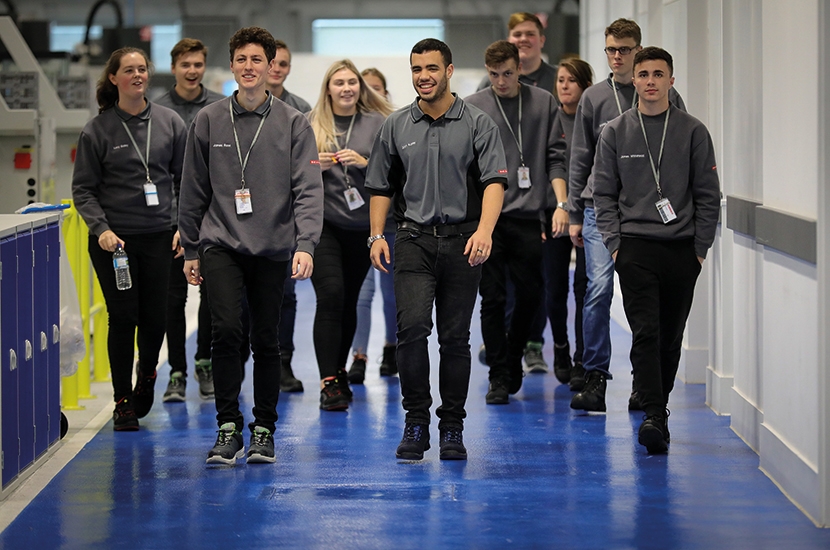We’ve all witnessed significant change in the past few years with the pandemic, climate crisis and the strained world economy impacting everyone’s lives. The war in Ukraine is having a devastating human cost, and has reminded us all of the importance of strong defence and security in the face of Russian aggression.
The Royal Air Force (RAF) Typhoon aircraft, manufactured and built in the UK, continue to play a crucial role in protecting the United Kingdom and its allies. They provide around-the-clock quick reaction alert, protecting the nation and playing a critical part in securing Nato airspace as part of the Allied response following the Russian invasion of Ukraine.
As the UK’s sovereign combat air provider, we recognise the critical importance and responsibility of our role, together with our partners Leonardo and Rolls-Royce, in delivering sovereign capability that provides the UK with independence in how we design, procure and deploy air power. The products and services we provide the Royal Air Force, along with the know-how and specialist skills we preserve and develop, ensure the UK has the means and freedom to choose how it deploys combat air capability.

We should be in no doubt that sovereign air power is a critical national asset. It is key to national security, to defending contested air space and achieving global influence, supporting relations with key allies and alliances such as Nato. It provides the UK with a crucial advantage, leverage and independence to mobilise combat air power in times of need.
We should be in no doubt that sovereign air power is a critical national asset
The link between military advantage and national economic prosperity cannot be overestimated. The UK’s combat air sector has a strong track record of delivering substantial military benefit as well as contributing to productivity, high-value jobs and significant economic return to the country.
From its heartland in the north of England, the combat air footprint reaches all regions of the United Kingdom, driving prosperity across the nation and supporting the ‘levelling up’ agenda. Through our work with thousands of UK companies in the supply chain, combat air programmes stimulate advanced manufacturing and technology development which bring a broader benefit to the UK.
The return on investment is delivered in the knowledge, skills and ability to design and build combat air systems in the UK, while spinning off UK-owned technology into the civil market and contributing to economic prosperity.
Designing and building complex, world-leading combat air systems such as Tempest, the UK’s next generation combat air system, supports our position at the forefront of technology and as a science powerhouse on the global stage.
Long-term investment in the UK sovereign combat air sector therefore not only ensures the security of the nation, but also helps advance the UK’s science and technology capability, creates skilled jobs that contribute to national prosperity and plays a role in improving the UK’s global competitiveness.
Four years ago this month, the UK launched its combat air strategy, which provided the foundations for a continuous and evolving combat air capability for the RAF, delivered through upgrades to Typhoon and F-35 aircraft and the launch of Tempest. The strategy confirmed the UK’s combat air sector as a critical national asset, and set out the UK’s determination to remain at the leading edge of combat air capability to protect our people, project influence and promote prosperity.
Tempest is a highly ambitious programme requiring the design and development of several ‘world firsts’ in aviation. As with the programmes that came before it, Tempest will deliver significant long-term economic and social benefit to the UK, and is already acting as a magnet for collaboration, innovation, encouraging R&D investment and driving new skills.

More than 2,000 people are already working on the early stages of the programme. As industry we are transforming our approach, working with 26 of the UK’s leading academic organisations and more than 90 innovative technology SMEs alongside our traditional defence supply chain.
The UK combat air industry is a major employer of STEM apprentices and graduates, training our people in areas such as advanced manufacturing, aeronautics, industrial digitisation, additive manufacturing, artificial intelligence, data analytics, robotics and virtual and augmented reality.
These critical skills and capabilities ensure the UK can continue to operate at the forefront of world-leading technology. The programme is inspiring the younger generation, across all regions, to pursue STEM careers, and more than 1,000 graduates and apprentices have been recruited across the main industrial companies since Tempest launched. The programme will increase economic productivity and prosperity by developing new products, services and jobs reaching many regions across the UK.
It can also create major export potential for the UK, delivering significant value back to the economy and strengthening partnerships around the world. Excluding the significant benefit from exports, the programme is forecast to deliver £100 billion of economic value to the UK and continue to support 21,000 jobs across the UK.
As we can see today, with an intensifying and evolving global threat, the UK’s ability to continue to generate and employ combat air power remains critical to delivering national security, supporting our economy and underpinning key international relationships – which have never been more important.
This article is free to read
To unlock more articles, subscribe to get 3 months of unlimited access for just $5






Comments
Join the debate for just $5 for 3 months
Be part of the conversation with other Spectator readers by getting your first three months for $5.
UNLOCK ACCESS Just $5 for 3 monthsAlready a subscriber? Log in